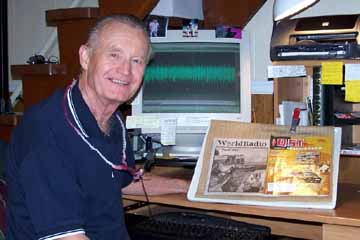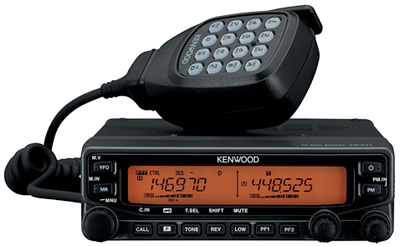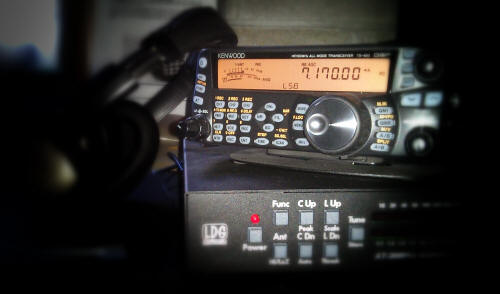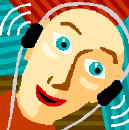Courage Center Handiham World Weekly E-Letter for the week of Wednesday, 05 December 2012
This is a free weekly news & information update from Courage Center Handiham System. Our contact information is at the end, or simply email handiham@couragecenter.org for changes in subscriptions or to comment. You can listen to this news online.MP3 audio stream:
http://www.handiham.org/audio/handiham.m3u
Download the 40 kbs MP3 audio to your portable player:
http://www.handiham.org/audio/handiham.mp3
Get this podcast in iTunes:

http://www.itunes.com/podcast?id=372422406
RSS feed for the audio podcast if you use other podcasting software:
http://feeds.feedburner.com/handiham
Welcome to Handiham World.
Meet the TOP BAND - 160 meters

This week we are taking a look at what has long been called "the top band" by old-timers in Amateur Radio.
The 160 meter amateur
band covers 1.8 to 2.0 MHz. The ARRL Frequency Chart notes that we are to
"avoid interference to radiolocation operations from 1.9 to 2.0
MHz". This is to protect the LORAN (LOng Range RAdio Navigation)
system from interference, but the fact of the matter is that this old technology
has effectively been replaced with the much more reliable GPS navigation system
and there are really no worries about interference these days.
The entire 160 meter band
is open to RTTY and data (including CW) and phone and image modes. Its
entire spectrum is also open to Extra, Advanced, and General license
holders. It's really not a fussy band with a lot of restrictions by mode
or license class.
As you know, the lower
the frequency, the longer the length of the radio's wave - the wavelength.
A typical dipole antenna used on the HF (High Frequency) bands is about a
half-wavelength long, ensuring that it will be resonant at the correct
frequency. A resonant antenna will have a low standing wave ratio and will
efficiently radiate RF energy at the desired frequency. So if we are
talking about the 160 meter band, a half wavelength would be a whopping 80
meters. A meter is about 39 inches, a bit over three feet. If you
use the tried and true formula 468 divided by the frequency in MHz and you pick
1.9 MHz, a frequency in the center of the band, you get an antenna length of
about 246 feet and 3 inches for the length of your half-wave dipole. I
don't know about you, but not many ham radio operators have that kind of real
estate in which to string antennas. The length of the antenna has often
been a deciding factor in whether one chooses to try the "top
band". If you live on a smaller city lot, it just may seem more
practical to put up antennas for the higher frequency bands because they are
shorter and easier to fit into a city lot. A 20 meter dipole is only about
33 feet long by comparison. Even though your transceiver probably has the
capability of working on 160, it might end up being a band you never try because
of the antenna requirements.
What can you expect to
hear if you tune around the 160 meter band? Well, nothing much if you are listening
during the daylight hours. The band will effectively be closed to all but
very close ground wave communications because of absorption of those wavelengths
when the sun is out. Once the sun sets, 160 begins to come to life.
Stations from hundreds, even sometimes thousands, of miles can be heard. The
winter months tend to be best for using the top band because there are more
hours of darkness and the band can really open up. Winter is also better because
there is less interfering static (QRN) from thunderstorms. Summer storms
are a major headache for 160 meter communications, so if you operate 160 in the
summer months the quietest time with the least interference with the band still
open is probably right around sunrise.
You can work all states
on 160 and even work DX, but most QSOs I hear on the top band are contacts
between groups of friends who prefer to meet on a less-crowded band for a casual
roundtable conversation. It can be an excellent band to have at the bottom of a
sunspot cycle when the higher frequencies are less than impressive. If you
have an AM radio (don't laugh - they are a disappearing species), you can use it
to tune around in the evening to hear distant stations. If far away
stations are coming in on the AM broadcast band, then the 160 meter band is
probably wide open as well. The two bands are nearby neighbors on the
frequency spectrum chart.
If you are intrigued by
the idea of trying 160 meters but put off by the antenna challenge, don't despair.
Antennas that do not physically fit into a city lot can still be made to fit
electrically by adding inductance - loading coils - to make the antenna the
correct electrical length to resonate in the band. There is no free lunch in
physics, so the efficiency of the loaded antenna will not be as high as that of
a full-size half-wave dipole. The bandwidth of a loaded antenna will also
generally be less, meaning that the usable frequency range around the resonant
frequency will not be as wide. This, at least, can usually be taken care
of with an antenna tuner. A dipole isn't the only antenna design to
consider. You might choose a Marconi antenna (end-fed wire) tuned at the
feedpoint. A vertical antenna with a loading coil near the base can also
be a way to get on 160 when real estate is at a premium. In fact, the new crop
of 43 foot vertical antennas offered by a number of manufacturers can be made
resonant on 160 with base loading. Marconi antennas and verticals need to be fed
against a good ground system, preferably with multiple ground radial wires. It
may be necessary to acquire a more serious antenna tuner than the one built into
a transceiver. For really efficient 160 meter tuning, it is best to have a
bigger external tuner because it will be more efficient and be able to cope with
a wider range of matching conditions. The typical internal automatic antenna
tuner is not much good for SWR readings of 3:1 or higher, and even then it's
problematic. You can easily encounter high SWR readings when trying to tune a
160 meter antenna.
Still thinking 160 might
be for you? Here's what you need to get started:
-
HF transceiver capable of operating on the 160 meter band.
-
Antenna assessment to help you plan for and choose the correct antenna system for your situation.
-
Antenna and tuner (if required) installed and tested with help from your local radio club or a knowledgeable fellow ham with antenna experience.
-
Free time to listen and operate in the evening and nighttime hours, or in the very early morning.
-
Patience - it will take a while to learn how the 160 meter band works.
-
Plan to listen or participate in the next big 160 meter event, the CQ World Wide 160-Meter Contest, if you have your station ready by January. Here are the particulars:The 2013 CQ World-Wide 160-Meter Contest
-
CW: 2200Z January 25 to 2200Z January 27
-
SSB: 2200Z February 22 to 2200Z February 24
-
ARRL also sponsors a 160
meter contest, but it was recently completed just a few days ago, so look for
the next one near the end of November 2013.
Next time: The
75/80 meter band.
Let's get out there and
enjoy HF!
Email me at handiham@couragecenter.org with your questions & comments. Patrick Tice, WA0TDA
Handiham Manager
Handiham Manager’s Technology Award goes to KK4JZX

In 2012 we decided to promote Science, Technology, Engineering, and Math - STEM - as part of our amateur radio mission. To that end we have created the Handiham Manager's Technology Award, to be presented to a person whose volunteer effort on behalf of the Handiham System in the area of technology has significantly advanced assistive technology, accessibility, or communications technology resulting in an advancement of the state of the art for the benefit of Handiham members.
The 2012 award goes to Jose Tamayo, KK4JZX, for his dedication to the Handiham Remote Base software update project. Jose has done exemplary work to debug and update the existing W4MQ remote base client software, leading the beta testing team and working to build accessibility into the newest version of the client.
It is my pleasure to recognize Jose and to congratulate him on his achievement.
Patrick Tice, WA0TDA
Handiham Manager
Volunteers needed

Handiham volunteers help us with recording projects and are much appreciated by our blind Handiham members. In this photo we see Bob Zeida, N1BLF, posing at his computer where he has recorded countless hours of audio for his school district and for the Handiham program. The demands on Bob are considerable, and we have more audio recording needs than he can possibly handle. Other volunteers like Ken Padgitt, W9MJY, record audio for us each month. Bob and Ken know that recording for those who cannot read regular print is a wonderful way to share one's time and talent with others who want to learn more about amateur radio, learn how to run a transceiver, or understand a concept in electricity and electronics.
Some recording jobs are as straightforward as reading printed copy word for word with perhaps a pause or two in order to explain a picture or figure. Others involve more or less freestyle teaching into a microphone about how to operate a radio. You can do that kind of teaching even if you cannot see to use regular printed materials yourself. If you know a radio and can use it well, why not share this knowledge with other Handiham members by making an audio tutorial? It's a lot like explaining something over the telephone - once you get the hang of it, the process is pretty simple. Volunteers Joe, N3AIN, and Matt, KA0PQW, have made excellent audio tutorials on different models of radios from a blind operator's perspective. Don't assume you need to see to do this work. While you do need to see to read printed pages, you can make audio tutorials whether you are blind or sighted.
Years ago, people used tape recorders to make audio recordings. Today the computer is the tool of choice. In the picture of Bob above, you can see the waveform of recorded audio on his computer screen in the background. Some people prefer the portability of a digital recorder, which can later be attached to the computer for transfer and processing of the audio file. Virtually any modern computer can be a sound recording studio for next to nothing in cost. You do need a decent microphone, preferably a headset microphone, and recording software like Audacity, which is free, open-source, and cross-platform. That means it will work on Windows, Mac, and Linux computers. Recorded audio can be sent to Handiham headquarters via several internet services, which are also free - assuming you already have internet service at home.
Recording for your fellow hams is a great Handiham volunteer activity. You don't need to go out in the snow, sleet, and rain. There is no heavy lifting, high voltage, or tower climbing. You can do it at home on your own schedule. We don't care if you are a night owl or an early bird. We can even pair you up with recording tasks that match your interests.
Can you help? Drop me a line or give me a call. Don't sit in front of the TV all winter long - read for your fellow amateurs and share the fun!
Patrick Tice, WA0TDA, Handiham Manager
Handiham@CourageCenter.org
763-520-0511
Correspondence:

Avery, K0HLA says:
Get ready for 12/12/12 - December 12, 2012 !Ken, KB3LLA, likes several books about the iPhone from National Braille Press, including Getting Started with the iPhone and iOs5 for Blind Users:
http://www.nbp.org/ic/nbp/IPHONE-IOS5.htmlHandiham Nets

We are on the air daily at 11:00 USA
Central Time, plus Wednesday & Thursday evenings at 19:00 USA Central
Time.
Join us on the Thursday evening Handiham Radio Club
TechNet. The frequency in the local Minnesota repeater coverage zone: 145.45 FM, negative
offset with no tone and 444.65 MHz with 114.8 Hz tone in the Twin Cities of
Minneapolis and St. Paul Minnesota. The UHF repeater will be heard more easily
in the Eastern Twin Cities. You will find our daily net on the air at
11:00 hours USA Central Time, with a Sunday roundtable session for a change of pace. A Wednesday evening session at 19:00 hours
USA Central Time also offers a chance to take a guess at a trivia question
(offered by some Net Control Stations) and
visit with your friends on the air. Ideal for those who can't make the daily
morning session! Then Thursday evening at 19:00 hours return to the Tech net and
learn something new.
EchoLink nodes:*HANDIHAM* conference server Node 494492 (Our preferred high-capacity node.)
*VAN-IRLP*, node 256919
KA0PQW-R, node 267582
KA0PQW-L, node 538131
N0BVE-R, node 89680
Other ways to connect:
IRLP node 9008 (Vancouver BC reflector)
WIRES system number 1427
A dip in the pool

It's time to test our knowledge by taking a dip in the pool - the question pool, that is!
Let's go to the Extra Class pool and take a look at four related questions about HF propagation.
E3B04 asks: "What type of propagation is probably occurring if an HF beam antenna must be pointed in a direction 180 degrees away from a station to receive the strongest signals?"
Possible choices are:
A. Long-path
B. Sporadic-E
C. Transequatorial
D. Auroral
E3B05 asks: "Which amateur bands typically support long-path propagation?"
Possible choices are:
A. 160 to 40 meters
B. 30 to 10 meters
C. 160 to 10 meters
D. 6 meters to 2 meters
E3B06 asks: "Which of the following amateur bands most frequently provides long-path propagation?"
Possible choices are:
A. 80 meters
B. 20 meters
C. 10 meters
D. 6 meters
And finally, E3B07 asks: "Which of the following could account for hearing an echo on the received signal of a distant station?"
Possible answers are:
A. High D layer absorption
B. Meteor scatter
C. Transmit frequency is higher than the MUF
D. Receipt of a signal by more than one path
These questions all relate to long-path propagation in some way. If an HF beam antenna must be pointed in a direction 180 degrees away from a station to receive the strongest signals, that means that you are receiving a signal by long path propagation. The signal is traveling around the Earth instead of via the most direct, shorter path that you might expect. As for which amateur bands typically support long-path propagation, you might be surprised to learn that although long-path is most common on 20 meters, all the bands found on the typical HF transceiver, 160 to 10 meters, are subject to long-path propagation. If you hear an echo on the received signal of a distant station, that is a sign that the signal is traveling to your receiver by more than one path. The correct answers are A, C, B, D.
Please e-mail handiham@couragecenter.org to comment.
Remote Base health report: W0EQO is on line. W0ZSW is on line.

Work continues on the remote base software. Both stations are accessible via Echolink for receive. Look for W0ZSW-L and W0EQO-L using the search function in your Echolink application. Please note that it is not allowed to connect through RF to the two remote base Echolink nodes, you can only use the Echolink application of a computer or smartphone.
If problems show up, please email handiham@couragecenter.org.
Keyboard commands list updated:
http://handiham.org/remotebase/w4mq-keyboard-commands/
Solar Activity Forecast: Solar activity is expected to be at very low to low levels on days one, two, and three (05 Dec, 06 Dec, 07 Dec).
Credit: NOAA Space Weather Prediction Center:
www.swpc.noaa.gov/forecast.html
This week @ HQ

Plan now to contact the Handiham office with your news or address changes, stories to share, or anything else that needs to be completed before year's end. The Handiham office will close for the week of Christmas through the end of the year and will reopen after New Year's Day. That means that once Nancy leaves the office at 2pm USA Central Time on December 20, any business you have left until the last minute will have to wait for the first week in January! Please plan ahead - it will not be possible to get in touch with us during the last 10 days of the month! During that time we will keep the website up to date and assure that the remote base stations are operational. The nets will continue on a regular schedule most days, but family holidays are special and sessions may be simple open round tables if no net control shows up.
Change in address for equipment donations: Please contact Pat, WA0TDA, before making any donation of equipment. My phone number is 763-520-0511 and my email address is pat.tice@couragecenter.org. The address is now the same as our postal mailing address. This should simplify our contact information.
Courage Center Handiham System
3915 Golden Valley Road
Golden Valley, MN 55422
Equipment change: We no longer accept antennas, except small accessory antennas for handheld radios. We do not accept donations of cassette tapes or tape equipment or used magazines.
No more tape digests and manuals
Please remember that the cassette tape digest ceases following the mailing at the end of November! After that all audio is in DAISY digital format or on line through the members only section of handiham.org. The Library of Congress 4-track tape system will no longer be supported in any form after 2012.George, N0SBU, reminds us that the final tape digest mailing is out and we will no longer support cassette tapes. We do not accept donations of cassette tapes or tape equipment.
The December Audio Digest is in preparation for digital DAISY cartridges, but we are still waiting for some audio to be submitted. December DAISY files are available in the DAISY section of the website following member login.
Digital mailers are important: If you do mail a digital cartridge to us, please be sure that it is an approved free matter mailer. Otherwise it will quickly cost us several dollars to package and mail out, which is more than the cost of the mailer in the first place. We don't have a stock of cartridges or mailers and not including a mailer will result in a long delay getting your request back out to you.
DAISY audio digests are available for our blind members who do not have computers, playable in your Library of Congress digital player. Handiham members who use these players and who would prefer to receive a copy of the monthly audio digests on the special Library of Congress digital cartridge should send a blank cartridge to us in a cartridge mailer (no envelopes, please), so that we can place the files on it and return it to you via free matter postal mail. Your callsign should be on both the cartridge and the mailer so that we can make sure we know who it's from. Blank cartridges and mailers are available from APH, the American Printing House for the Blind, Inc.
Digital Talking Book Cartridge Catalog Number: 1-02610-00, Price: $12.00
Digital Talking Book Cartridge Mailer Catalog Number: 1-02611-00, Price: $2.50
Order Toll-Free: (800) 223-1839.
The Library of Congress NLS has a list of vendors for the digital cartridges:
http://www.loc.gov/nls/cartridges/index.html
Get it all on line as an alternative: Visit the DAISY section on the Handiham website after logging in.
Stay in touch

Be sure to send Nancy your changes of address, phone number changes, or email address changes so that we can continue to stay in touch with you. You may either email Nancy at hamradio@couragecenter.org or call her at 763-520-0512. If you need to use the toll-free number, call 1-866-426-3442.
Handiham Manager Patrick Tice, WA0TDA, may be reached at handiham@couragecenter.org or by phone at 763-520-0511.
Mornings Monday through Thursday are the best time to contact us.
The Courage Handiham System depends on the support of people like you, who want to share the fun and friendship of ham radio with others. Please help us provide services to people with disabilities. We would really appreciate it if you would remember us in your estate plans. If you need a planning kit, please call. If you are wondering whether a gift of stock can be given to Handihams, the answer is yes! Please call Walt Seibert, KD0LPX, at 763-520-0532 or email him at walt.seibert@couragecenter.org.
Call 1-866-426-3442 toll-free. -- Help us get new hams on the air.
Get the Handiham E-Letter by email every Wednesday, and stay up-to-date with ham radio news.
You may listen in audio to the E-Letter at www.handiham.org.
Email us to subscribe:
hamradio@couragecenter.org
That's it for this week. 73 from all of us at the Courage Handiham System!
Pat, WA0TDA
Manager, Courage Handiham System
Reach me by email at:
handiham@couragecenter.org
Nancy, Handiham Secretary:
hamradio@couragecenter.org
ARRL is the premier organization supporting amateur radio worldwide. Please contact Handihams for help joining the ARRL. We will be happy to help you fill out the paperwork!

The weekly e-letter is a compilation of software tips, operating information, and Handiham news. It is published on Wednesdays, and is available to everyone free of charge. Please email handiham@couragecenter.org for changes of address, unsubscribes, etc. Include your old email address and your new address.
Courage Center Handiham System
3915 Golden Valley Road
Golden Valley, MN 55422
763-520-0512
hamradio@couragecenter.org